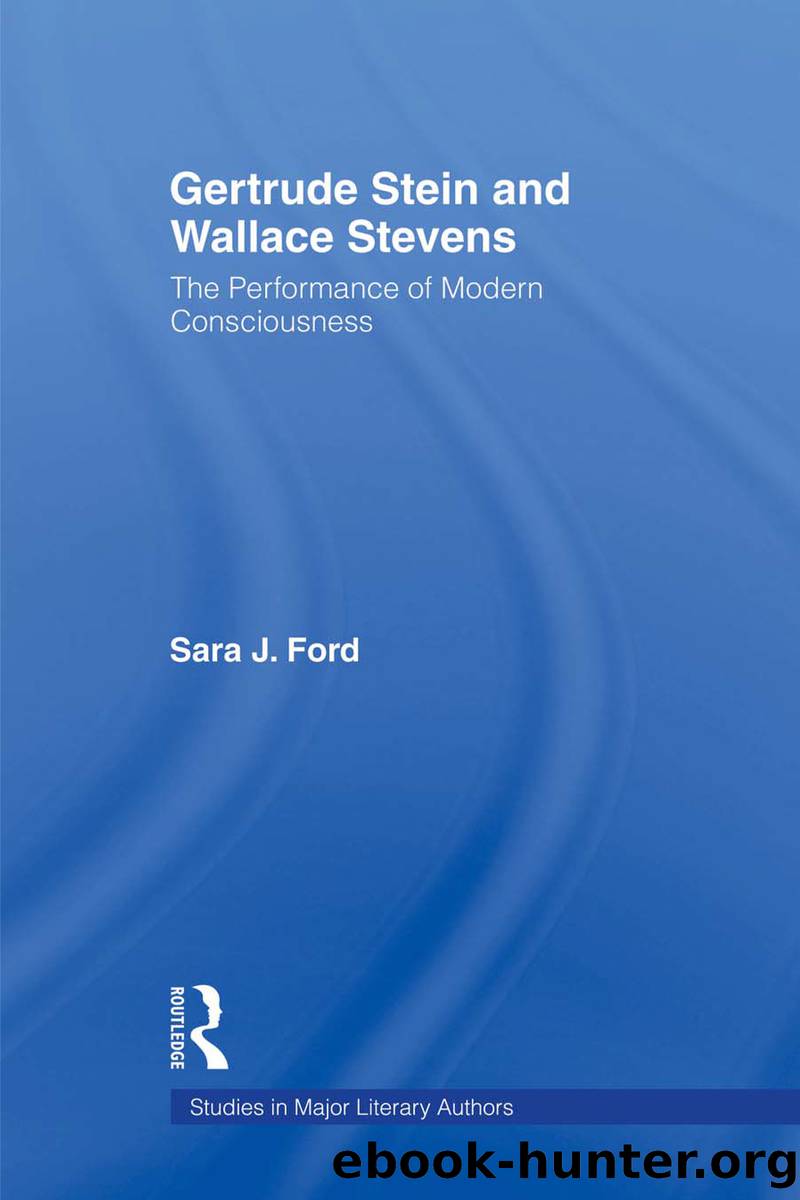Gertrude Stein and Wallace Stevens by Ford Sara J.;

Author:Ford, Sara J.; [Ford, Sara J.]
Language: eng
Format: epub
Publisher: Taylor & Francis Group
Published: 2022-05-25T00:00:00+00:00
Chapter 4 Stevens' Verse Plays The Drama of the Mind
DOI: 10.4324/9780203616987-4
I know myself to be incalculable, since the causes of what I am are incalculable.
âWallace Stevens, Carlos Among the Candles
To look at ordinary things intensely, is not to see things as they are.
âWallace Stevens, Bowl, Cat and Broomstick
Not often considered alongside the works of Gertrude Stein, the writings of Wallace Stevens are equally steeped in notions related to performance and the play. At first glance, these two modernists seem to have inhabited entirely different literary worlds, and Stevensâ letters indicate the extent of this difference, at least in his mind. In letters he claims to find Stein's style âshallow,â and he refers to the Hartford production of Four Saints as âan elaborate bit of perversity.â1 The differences between the two writers are great, and I do not wish to suggest otherwise. However, the central philosophical difficulties with which Stevens grappled throughout his literary career share affinities, on an important level, with the concerns central to Stein's canon. Both writers present related responses to the modern discourse surrounding both consciousness and the purpose and nature of artistic expression. Like Stein, Stevens was interested in the extent to which external relationships determine the self, and he was likewise interested throughout his career in the value and potential of artistic expression. In addition, both of these modernist writers developed ways of staging particular moments of consciousness in order to understand better the modern self and its relation to artistic expression.
Unlike Stein's Tender Buttons, Stevensâ work posits a reality that remains beyond the bounds of human construction. This reality is in a state of ever-changing flux, a âwave, interminably flowingâ (âPeter Quince at the Clavierâ). Sukenick calls it âa fluid, constantly changing present in which nothing endures and nothing has any end beyond itself.â2 Human perception's access to this reality, according to Stevens, is limited in a number of ways. For instance, reality is constantly changing, so human perceptions can maintain only temporary validity, and reality is much larger than the scope of a single perspective could ever come to terms with. At any given moment of consciousness, the self must see itself in the world according to a very limited perspective on reality. As consciousness perceives, it does so according to associations, and a poem, therefore, cannot hope to offer objective or finite descriptions of reality. It can, however, actively strip away old and stale associations and replace them with newer ones that might, even if only temporarily, offer a fresh relationship with reality. As a performance, however, poetic consciousness is not without agency. Poetic imagination, according to Stevens, includes the act of stripping away old associations, denying certain determining relationships while discovering and creating new ones. In this model, as in Stein's, artistic expression is not absolutely determined but is a kind of negotiation, in this case between the acknowledgment that we must always remain determined by external relationships and the act of constantly stripping away and renewing such relationships.
Between the spring
Download
This site does not store any files on its server. We only index and link to content provided by other sites. Please contact the content providers to delete copyright contents if any and email us, we'll remove relevant links or contents immediately.
4 3 2 1: A Novel by Paul Auster(11788)
The handmaid's tale by Margaret Atwood(7447)
Giovanni's Room by James Baldwin(6808)
Asking the Right Questions: A Guide to Critical Thinking by M. Neil Browne & Stuart M. Keeley(5355)
Big Magic: Creative Living Beyond Fear by Elizabeth Gilbert(5351)
Ego Is the Enemy by Ryan Holiday(4956)
On Writing A Memoir of the Craft by Stephen King(4662)
The Body: A Guide for Occupants by Bill Bryson(4580)
Ken Follett - World without end by Ken Follett(4443)
Bluets by Maggie Nelson(4260)
Adulting by Kelly Williams Brown(4232)
Eat That Frog! by Brian Tracy(4149)
Guilty Pleasures by Laurell K Hamilton(4116)
White Noise - A Novel by Don DeLillo(3829)
The Poetry of Pablo Neruda by Pablo Neruda(3813)
Fingerprints of the Gods by Graham Hancock(3733)
Alive: The Story of the Andes Survivors by Piers Paul Read(3729)
The Book of Joy by Dalai Lama(3695)
The Bookshop by Penelope Fitzgerald(3619)
